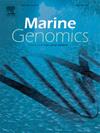Multi-tissue transcriptome of Brycon amazonicus (Spix & Agassiz, 1829): insights into lipid metabolism in an Amazonian fish
IF 1.5
4区 生物学
Q4 GENETICS & HEREDITY
引用次数: 0
Abstract
Brycon amazonicus (Spix & Agassiz, 1829), commonly known as matrinxã, is a widely distributed Amazonian native fish species with significant aquacultural importance, being the second most produced native fish in Brazil. Despite its economic relevance, omics resources are scarce, limiting advances in aquaculture and nutrition research. Here, we present the first comprehensive transcriptome for the species, generated using RNA-seq data from three tissues, i.e., liver, kidney, and gill. Our analysis yielded a high-quality transcriptome assembly, with 65,454 transcripts, a N50 of 1959 bp, and 34,548 functionally annotated protein-coding genes. To explore lipid metabolism, we identified key genes involved in the biosynthesis of long-chain polyunsaturated fatty acids (LC-PUFAs), namely the orthologues of the fatty acyl desaturase fads2 and the elongases elovl2 and elovl5. Comparative evolutionary and structural analyses revealed that B. amazonicus shares conserved features with other Amazonian fish, reinforcing its capacity for LC-PUFA biosynthesis. Overall, the results represent a significant advance in the genetic knowledge of this Brazilian emblematic fish, providing a valuable resource for future studies and ultimately helping to promote more sustainable fish farming practices.
亚马逊河Brycon amazonicus (Spix & Agassiz, 1829)的多组织转录组:对亚马逊河鱼类脂质代谢的见解
亚马逊Brycon amazonicus (Spix & Agassiz, 1829),俗称matrinxã,是一种分布广泛的亚马逊原生鱼类,具有重要的水产养殖重要性,是巴西产量第二大的原生鱼类。尽管具有经济意义,但组学资源稀缺,限制了水产养殖和营养研究的进展。在这里,我们展示了该物种的第一个综合转录组,使用来自三个组织(即肝脏,肾脏和鳃)的RNA-seq数据生成。我们的分析产生了一个高质量的转录组组合,有65,454个转录本,N50为1959 bp, 34,548个功能注释的蛋白质编码基因。为了探索脂质代谢,我们确定了参与长链多不饱和脂肪酸(LC-PUFAs)生物合成的关键基因,即脂肪酰基去饱和酶fads2和延长酶elovl2和elovl5的同源基因。比较进化和结构分析表明,亚马逊贝类与其他亚马逊鱼类具有相同的保守特征,增强了其LC-PUFA生物合成能力。总的来说,这些结果代表了这种巴西标志性鱼类遗传知识的重大进步,为未来的研究提供了宝贵的资源,并最终有助于促进更可持续的鱼类养殖实践。
本文章由计算机程序翻译,如有差异,请以英文原文为准。
求助全文
约1分钟内获得全文
求助全文
来源期刊

Marine genomics
生物-遗传学
CiteScore
3.60
自引率
5.30%
发文量
50
审稿时长
29 days
期刊介绍:
The journal publishes papers on all functional and evolutionary aspects of genes, chromatin, chromosomes and (meta)genomes of marine (and freshwater) organisms. It deals with new genome-enabled insights into the broader framework of environmental science. Topics within the scope of this journal include:
• Population genomics and ecology
• Evolutionary and developmental genomics
• Comparative genomics
• Metagenomics
• Environmental genomics
• Systems biology
More specific topics include: geographic and phylogenomic characterization of aquatic organisms, metabolic capacities and pathways of organisms and communities, biogeochemical cycles, genomics and integrative approaches applied to microbial ecology including (meta)transcriptomics and (meta)proteomics, tracking of infectious diseases, environmental stress, global climate change and ecosystem modelling.
 求助内容:
求助内容: 应助结果提醒方式:
应助结果提醒方式:


